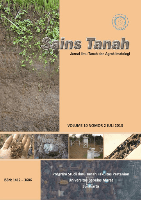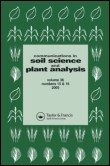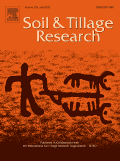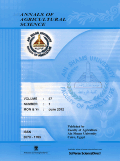
SAINS TANAH
Scope & Guideline
Promoting Innovative Solutions in Soil Health and Agriculture
Introduction
Aims and Scopes
- Soil Fertility and Nutrient Management:
Research exploring soil fertility, nutrient availability, and the impact of fertilizers (both organic and inorganic) on crop yield and soil properties. - Soil and Water Management:
Studies focusing on irrigation practices, water demand, and the influence of soil conditions on water retention and use in agricultural settings. - Environmental Impact and Soil Conservation:
Investigations into soil conservation techniques, erosion control, and the effects of land use changes on soil health and environmental sustainability. - Soil Microbiology and Biochemistry:
Research on the role of soil microorganisms in nutrient cycling, plant growth promotion, and soil health, including the use of biofertilizers. - Soil Amendments and Remediation:
Exploration of various soil amendments (e.g., biochar, compost) and their effects on soil quality, carbon sequestration, and pollution remediation. - Land Suitability and Agricultural Practices:
Assessment of land suitability for various crops based on soil characteristics, and studies on innovative agricultural practices that improve soil and crop productivity.
Trending and Emerging
- Sustainable Agriculture Practices:
A significant increase in research focused on sustainable agricultural practices, including organic farming, agroecology, and integrated nutrient management, highlighting the need for environmentally friendly approaches. - Impact of Climate Change on Soil:
Emerging studies examining how climate change affects soil properties, crop yields, and agricultural practices, underlining the importance of resilience in soil management. - Technological Innovations in Soil Science:
Growing interest in the application of technology, such as UAVs and remote sensing, for soil monitoring and management, reflecting the integration of modern techniques in traditional soil science. - Soil Health and Ecosystem Services:
An increasing trend in research exploring the relationship between soil health and ecosystem services, such as carbon sequestration and biodiversity, emphasizing the multifunctional role of soils. - Biofertilizers and Soil Microbial Dynamics:
A rise in studies focusing on biofertilizers and the dynamics of soil microorganisms, illustrating a shift towards understanding the biological aspects of soil fertility and plant growth.
Declining or Waning
- Heavy Metal Contamination Studies:
Research specifically targeting heavy metal contamination in soils has decreased, possibly indicating a shift towards broader environmental health topics or alternative contaminant assessments. - Traditional Soil Classification Methods:
There has been a waning interest in traditional soil classification systems, with more emphasis now on integrated approaches that consider multiple factors affecting soil health. - Conventional Agricultural Practices:
Papers focusing solely on conventional agricultural practices without considering sustainable alternatives have become less common, reflecting a broader trend towards sustainable agriculture. - Single Crop Studies:
Research that centers exclusively on single crops without integrating multi-crop or agroecological perspectives has seen a decline, as the focus shifts towards systems-based approaches for sustainability.
Similar Journals

COMMUNICATIONS IN SOIL SCIENCE AND PLANT ANALYSIS
Connecting Science and Sustainability in Soil and Plant AnalysisCOMMUNICATIONS IN SOIL SCIENCE AND PLANT ANALYSIS, published by Taylor & Francis Inc, is a prestigious journal dedicated to advancing research in the fields of agronomy, crop science, and soil science. Established in 1970, the journal has maintained a significant presence over the years, with a commitment to publishing high-quality, peer-reviewed articles that contribute to the understanding of soil and plant interactions. With an impressive Q2 ranking in both Agronomy and Soil Science, it positions itself as a vital resource for researchers, professionals, and students alike, keen on exploring innovative solutions to contemporary agricultural challenges. Although it currently does not provide open access, the journal ensures wide dissemination through its established subscription services. The journal's focus on empirical research, methodologies, and technological advancements in soil management and plant nutrition makes it an essential platform for disseminating knowledge and fostering discussions within the scientific community. Located in the heart of Philadelphia, USA, it remains a significant contributor to the global dialogue on sustainable agriculture and environmental stewardship.

SOIL & TILLAGE RESEARCH
Advancing Soil Science for Sustainable FuturesSOIL & TILLAGE RESEARCH is a premier international journal dedicated to advancing the understanding of soil science and tillage practices through high-quality research and insightful reviews. Published by Elsevier and based in the Netherlands, this esteemed journal boasts impressive impact metrics, being ranked in the Q1 category across multiple domains including Agronomy and Crop Science, Earth-Surface Processes, and Soil Science, reflecting its pivotal role in the academic community. With an H-Index that underscores its citation impact and a Scopus ranking placing it in the top percentiles of its field, SOIL & TILLAGE RESEARCH serves as a vital resource for researchers and professionals focusing on sustainable agricultural practices, soil management, and environmental conservation. This journal provides a platform for open dialogue and dissemination of knowledge that shapes future research directions and policy-making in land use and sustainable agriculture.

Agrivita
Exploring innovative solutions in agronomy and crop science.Agrivita is a distinguished, open-access journal dedicated to advancing research and knowledge in the fields of Agronomy and Crop Science. Published by Brawijaya University, Faculty of Agriculture, this journal has been providing a platform for high-quality scholarly articles since 2010. Located in the vibrant country of Indonesia, Agrivita plays a vital role in the exchange of innovative agricultural research, particularly within the Southeast Asian context. As of 2023, it holds a respectable Q3 ranking in its category, showcasing its commitment to scholarly excellence and visibility. With an increasing impact on the academic community, and its current Scopus rank placing it in the 48th percentile, Agrivita stands as a crucial resource for researchers, professionals, and students eager to deepen their understanding of crop science and agronomy. The journal's scope encompasses cutting-edge research that addresses both fundamental and applied aspects of agriculture, ensuring it remains relevant to today's pressing agricultural challenges. Its open access model enhances global accessibility, fostering a collaborative environment where diverse opinions and findings can converge.

Romanian Agricultural Research
Elevating Agricultural Insights for Tomorrow's ChallengesRomanian Agricultural Research is a prominent academic journal dedicated to advancing the field of agricultural science with a specific focus on agronomy and crop management. Published by the NATL AGRICULTURAL RESEARCH & DEVELOPMENT INST in Romania, this journal has established itself as an important resource within its discipline, evidenced by its Q3 ranking in the Agronomy and Crop Science category for 2023. With its ongoing publication since 2008, the journal provides a platform for researchers and professionals to disseminate their findings and share innovative practices that address the challenges faced in agricultural development. Although it operates under a non-open access model, Romanian Agricultural Research commits to rigorous peer-review processes, ensuring the high-quality content that enhances the academic community’s knowledge base. The journal's objective is to foster dialogues surrounding sustainable agriculture, improve crop yield, and contribute to the enhancement of agricultural practices globally. Researchers, professionals, and students will find this journal to be an invaluable repository of knowledge and a catalyst for future agricultural innovations.

Crop Forage & Turfgrass Management
Empowering research to elevate crop productivity.Crop Forage & Turfgrass Management, published by WILEY, serves as an essential platform for researchers, professionals, and students in the fields of agronomy, crop science, plant science, and soil science. With a focus on advancing knowledge in the management of crops, forage systems, and turfgrass, this journal plays a pivotal role in disseminating innovative research and practical applications that drive agricultural sustainability and productivity. Despite its Q3 ranking in various agricultural and biological science categories according to Scopus, it aims to enhance its impact and relevance in the academic community through high-quality publications. As a journal converged from 2015 to 2024, it invites contributions that address contemporary challenges and solutions in crop management, ensuring accessibility to vital knowledge for the advancement of agricultural practices. Situated in the United States, it also reflects the diverse agricultural landscapes and practices of the region, making it a valuable resource for a global audience.

ANNALS OF AGRICULTURAL SCIENCES
Exploring Innovations that Cultivate Tomorrow's SolutionsANNALS OF AGRICULTURAL SCIENCES, published by Elsevier, stands as a leading open access journal dedicated to the multifaceted field of agricultural sciences. Since its inception in 2011, this journal has served as a pivotal platform for the dissemination of high-quality research, covering areas such as agronomy, animal science, horticulture, food science, plant science, and soil science. With an impressive Q1 ranking across multiple disciplines and notable positions in Scopus Ranks—including #6 in Animal Science and Zoology and #3 in Horticulture—this journal is recognized globally for its significant contribution to advancing agricultural innovations. The journal caters to a diverse audience of researchers, professionals, and students, providing them with open access to cutting-edge studies that address critical issues in agricultural productivity and sustainability. Its commitment to high-impact research ensures that articles contribute meaningfully to the scientific community, fostering advancements in agricultural practices and policies.

Malaysian Journal of Soil Science
Nurturing Insights, Growing Agricultural Excellence.The Malaysian Journal of Soil Science, published by the Malaysian Society of Soil Science, serves as a vital platform for disseminating high-quality research in the fields of Agronomy and Crop Science as well as Soil Science. With an ISSN of 1394-7990, this peer-reviewed journal has made significant strides since its establishment in 2009, currently positioned in the Q2 quartile for both categories as of 2023. The journal aims to advance knowledge surrounding soil health and management practices, particularly within the Malaysian context, while also addressing global soil science issues. Despite being based in Malaysia, it welcomes contributions from a diverse range of geographies and viewpoints, enriching the academic discourse. Researchers and practitioners in this field will find a wealth of innovative studies and findings that reflect the current trends and challenges in soil management. Given its current rankings in Scopus, the journal plays a crucial role in shaping the future of soil science, making it indispensable for anyone dedicated to advancing research and practical applications in agricultural and environmental sciences.

Journal of Soil Science and Plant Nutrition
Fostering sustainable practices through cutting-edge research.The Journal of Soil Science and Plant Nutrition, published by SPRINGER INT PUBL AG, is a premier academic journal dedicated to advancing the fields of agronomy, plant science, and soil science. With an impressive Q1 ranking in both Agronomy and Crop Science and Plant Science, alongside a Q2 ranking in Soil Science, this journal stands at the forefront of innovative research and knowledge dissemination. Annually indexed in key databases, it provides a platform for high-quality research articles that explore the complex interactions between soil health and plant nutrition, contributing significantly to sustainable agricultural practices. Although it does not offer open access options, the journal is accessible through various academic institutions and libraries, ensuring a wide readership. With its emphasis on impactful findings, the journal is an essential resource for researchers, professionals, and students aiming to further their understanding and application of soil and plant science in an ever-evolving global context.

EGYPTIAN JOURNAL OF SOIL SCIENCE
Cultivating Knowledge in Soil Management and ConservationEGYPTIAN JOURNAL OF SOIL SCIENCE is a renowned publication dedicated to advancing the field of soil science, particularly within the context of Egypt and the broader regions of the Middle East and North Africa. Published by the NATIONAL INFORMATION DOCUMENTATION CENTER, ACADEMIC SCIENTIFIC RESEARCH & TECHNOLOGY, this journal aims to disseminate high-quality research and innovative practices related to soil management, conservation, and sustainable agricultural practices. With an emphasis on empirical studies, reviews, and methodologies relevant to soil health and productivity, this journal serves as an essential resource for researchers, professionals, and students alike. Although specific access options are not highlighted, the journal’s commitment to promoting scholarly discourse ensures that important findings within soil science are made available to wider audiences, contributing significantly to environmental science, agronomy, and ecological preservation.

EURASIAN SOIL SCIENCE
Transforming knowledge into action for soil health.EURASIAN SOIL SCIENCE, published by PLEIADES PUBLISHING INC, is a premier journal dedicated to advancing knowledge in the fields of soil science and earth-surface processes. With an ISSN of 1064-2293 and an E-ISSN of 1556-195X, this journal has been a key resource for researchers and professionals from its inception in 1992 and continues to thrive as it converges toward 2024. Situated in the United States, EURASIAN SOIL SCIENCE has achieved notable recognition, attaining a Q2 ranking in both Earth-Surface Processes and Soil Science categories as of 2023. Its Scopus rankings further underscore its importance, with Earth and Planetary Sciences placing it at #81/179 and Agricultural and Biological Sciences ranking it at #80/159. Engaging a global audience, this journal publishes cutting-edge research articles, reviews, and case studies that address critical issues related to soil health, conservation, and management. Though currently not open access, the journal offers valuable insights and fosters collaboration among scientists and practitioners, underscoring its vital role in enhancing the understanding of soil dynamics and sustainability.